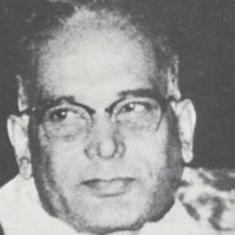Even though Tendulkar’s tally of six series-defining performances (SD) places him joint sixth on a Test list of series-defining tallies – after Inzamam-ul-Haq, Rahul Dravid, Graeme Smith, Kumar Sangakkara and Jacques Kallis – it is useful to remember that no one played as many Tests as Tendulkar.
His massive tally of Tests does not lead to a high SD–match ratio (which also reduces his career impact overall). Even more curiously, five of his six SDs in Tests came as a support act when someone either took the lead (Leeds, 2002; Chennai, 2008) or scored more than him (Colombo, 2010; Mohali, 2010) or contributed with him (Chennai, 1998).
Tendulkar’s was a consistent and significant support act for most of his career in matches that really mattered to his team from a series-defining angle – except for the 2008–11 phase, which was the best phase of his career, even more so than the 1996–99 phase, which is widely considered his greatest period. In fact, as mentioned before, the 2008–11 phase was the only period when Tendulkar was the highest impact batsman in the world.
Aakash Chopra (AC) It is quite fascinating that Tendulkar has shared that impact with others when India has done well. Of course, you cannot hold it against him that others have also done well, sometimes better, when he has contributed significantly. But questions will remain, like why there is not an instance where he has scored 60 per cent of the runs his team has made, or why he has never scored a triple hundred. Or that he never made 500 runs in a Test series; that’s a huge oddity for someone who has scored as many runs as he has. In the end, it shows that, even though Tendulkar produced superman-like numbers, he was also human.
Jaideep Varma (JV): There was an interview of Brian Lara with Ian Frazer sometime back, where Lara was asked why he got such big scores but Tendulkar didn’t. Lara said that Sachin was a one-pace player, and played the same no matter who bowled and whatever the situation of the game, whereas Lara picked bowlers and moments when he could get a burst of runs, and then he would pace himself until an opportunity for another burst came along.
This is fascinating, because it matches the macro picture as well. Tendulkar was, of course, incredibly consistent, but could it be that he did not raise his game when the big moments came, and played in the same mode all the time?
AC: See, most players will tell you that no one really thinks in terms of Test series that sharply. It is different in knockout games (in limited-overs cricket) where it is do or die. It is hard to identify what that do-or-die equivalent is here. So, when you’re batting in the first innings, you have no idea what its place will be in the end.
Similarly, you’re in the second Test of a series and you have no idea that this performance of yours will determine the series outcome. So, it is easy to join the dots in retrospect, but as a player, that is very hard to do. Once in a while, you do know that the series is at 1–1, and this is the last Test match, but not often.
And, look, he has been remarkably consistent, he has a 50 every 2.75 innings, which is incredible. Being a support act so often is very remarkable, right?
JV: Can god be a support act?
AC: But who says he is god? His peers don’t. All of us treat him as a great player. But we have all seen him fail, as everybody does – that is the nature of the beast. Also, you must remember that, until the late 1990s, Tendulkar did not have the reassurance of having Dravid in the team, which also made a difference.
JV: But interestingly, Tendulkar’s best phase in his career (2008–11) came when Dravid was having his worst phase. Which also means he was coming in sooner to bat.
AC: So, yes, he probably got more of a chance to make an impact then.
JV: Could the advent of T20 cricket also have had anything to do with Tendulkar’s best phase? After all, IPL began in 2008 too, and picked up during Tendulkar’s incredible second wind. Interestingly, Tendulkar’s impact for Mumbai Indians was the highest with the bat for that team, till 2011 (and if you leave out big matches, he was the second highest impact batsman in the IPL, which is remarkable).
He redefined his role as a sheet anchor’s, scoring a high proportion of runs and building partnerships at the cost of a lower strike rate. But could this fresh exciting format have made his juices ow again, and rekindled his desire to score runs in other formats too? More importantly, could that changed role at Mumbai Indians have permeated his thinking on the international stage too?
AC: It makes a lot of sense, for new challenges bring out the best in champion players. T20 cricket came really late in Tendulkar’s career but it’s worth remembering that the first avatar of Tendulkar we saw (way back in New Zealand, batting at Nos. 5 or 6) was ideal for this format. Tendulkar was an aggressive player at heart. Also, since the T20 format was in its infancy, and therefore the role of an anchor was still around. And yes, a new challenge can get you going all over again. You start thinking about reinventing your methods and that’s when you become a kid again.
An interesting reason why Tendulkar played a support role is that he batted in the easiest position in Test cricket history – proved both by impact and batting average (No. 4 has the highest batting average among all positions in Test history, despite the colossus Bradman batting mostly at No. 3). The challenges he avoided at that position were actually also opportunities he missed to register a greater impact on the game, a role Dravid and Laxman flourished in.
This is camouflaged by the volume of runs he made and the statistical monuments he built. (It is easy to also forget that his highest Test score of 248 not out is against Bangladesh.)
In most great Test teams, the best batsman comes in at No. 3. Tendulkar did not. The role that the openers and No. 3 played in making his work easier cannot be underestimated here, and they never get credit for it. Tendulkar stuck to No. 4 for his entire career.
It is curious that he opened only once in his career (and that too to garner quick runs in the third innings, so it doesn’t really count), despite having accomplished that very successfully in ODI cricket. He might have had a higher impact from there and the team might have been considerably stronger too, given the middle-order talent India was blessed with at the time.
Meanwhile, a number of hapless middle-order batsmen had their careers jeopardised by being forced to open, including Yuvraj, Dravid, Sehwag and even Laxman. Ganguly, if he wasn’t captain, would have been forced to open too. India could have lost many of these batsmen forever, but were lucky that Sehwag made such a great feast of it.
AC: It is true that No. 4 is an easier batting position than others. Opening the batting is tough, especially in overseas conditions – the bowlers are fresh – and No. 3 is tough for much the same reasons. Down the line, Nos. 5 and 6 have it tougher too, because the ball gets a bit softer, run-scoring is a little less easy, and you also run out of partners sometimes.

Excerpted with permission from Numbers Do Lie: 61 Hidden Cricket Stories, Impact Index with Aakash Chopra, HarperCollins India.










